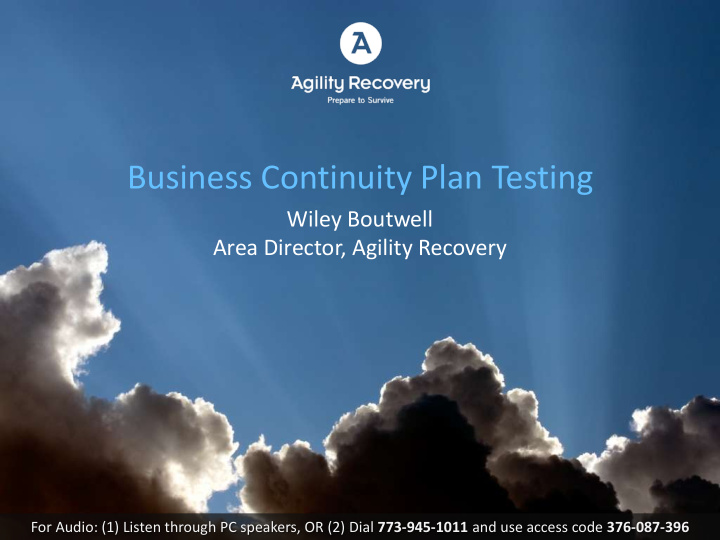



Business Continuity Plan Testing Wiley Boutwell Area Director, Agility Recovery For Audio: (1) Listen through PC speakers, OR (2) Dial 773-945-1011 and use access code 376-087-396
Today’s Agenda – November 11, 2010 • Testing Misconceptions • Reasons to Test • What to Test • Suggested Approaches • Building a Team • Learning from the Results For Audio: (1) Listen through PC speakers, OR (2) Dial 773-945-1011 and use access code 376-087-396
Common Misconceptions • Pass/Fail exam of the people or plan • Validation of backup data • Reading through the plan • One-time project
What does a good test accomplish? • Compliance • Customer demands • Validate and improve plan: reduce recovery time and COST • Increase employee and community confidence • Set realistic expectations with participants • Practice makes perfect
Planning Lifecycle • Do an annual test and then update the plan. Put It On Assess Your • Make sure to re-train employees Paper Business when making changes to the plan. • Publish test results as addenda to Test, your plan so your test program Evaluate, can evolve and grow. Revise
High-Level Approach Simple vs. More Complex • Table-top vs. Hands-On • IT focus vs. Business focus • Internal vs. Supply Chain
Detailed Scope Focus on functions that are: • Critical • Weak or unreliable Get input from participants on what they hope to learn Get an expert outside opinion Common Elements: • Local Servers • Phones – inbound/outbound • Supply Chain • Workflow – manual processes • Emergency Communications
Test All Elements Over Time • Business Continuity Plan • People - Employees & Community • Building - Current office(s) & recovery sites • Power • Connectivity - Telephony & Internet • Technology - Hardware, software, & support
Evacuation Drilling • Drill for relevant threat(s) • Plan ahead for area evacuations • Hold managers responsible • Vary hazards presented • Practice and time office lock-up • Request Feedback
Communication Plan Testing If you can reach your people you can create solutions Store your complete plan online • Resource needs for recovery • Internal communication strategy • Messaging service to email/text/voice • Upload critical files and templates • Requires Internet (have hard-copies too) Challenge assumptions • Whatever your plan says, make sure it works • Backup if plan A fails to reach everyone (alternate numbers, physical meeting place) • Regular training to set expectations • Public relations
Utility Failure Testing • Power Failure • Phone Failure • Internet/Network Failure
Sample Scope Primary Goal: Restore 3 critical servers from backup media • Which are critical? Email, database, customer mgmt system • Restore method? Tape, disk, online, image, virtual machine Secondary Goal: Validate network and Internet access • For which files/applications do I need to confirm access? • Are the speed and reliability acceptable for use in recovery? Tertiary Goal: • I nbound/Outbound Phone calls with home office • Restore workstation/PC software • Printing, scanning, faxing • Identify workflow changes
Assessing the Results Take notes during the exercise • What was the task or issue? • When was it started/identified? • Was it resolved? How? Review the findings with participants • As test is completed • Again after notes are compiled Assign responsibilities for open items Update and distribute written plan Notes for consideration on next test
Conclusion • You need to test your plan • Build business continuity testing into the budget and your company culture • Many ways to test, so be creative • Use available testing experience and resources • Identify goals to ensure valid results • Success means improving your Plan and ability to recover from disaster
Questions? Submit questions using the Q&A Function on the screen.
Recommend
More recommend